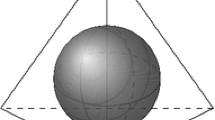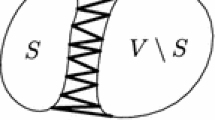Abstract
We estimate the selection constant in the following geometric selection theorem by Pach: For every positive integer d, there is a constant \(c_d > 0\) such that whenever \(X_1, \ldots , X_{d+1}\) are n-element subsets of \(\mathbb {R}^d\), we can find a point \({\mathbf {p}}\in \mathbb {R}^d\) and subsets \(Y_i \subseteq X_i\) for every \(i \in [d+1]\), each of size at least \(c_d n\), such that \({\mathbf {p}}\) belongs to all rainbow d-simplices determined by \(Y_1, \ldots , Y_{d+1}\), i.e., simplices with one vertex in each \(Y_i\). We show a super-exponentially decreasing upper bound \(c_d\le e^{-(1/2-o(1))(d \ln d)}\). The ideas used in the proof of the upper bound also help us to prove Pach’s theorem with \(c_d \ge 2^{-2^{d^2 + O(d)}}\), which is a lower bound doubly exponentially decreasing in d (up to some polynomial in the exponent). For comparison, Pach’s original approach yields a triply exponentially decreasing lower bound. On the other hand, Fox, Pach, and Suk recently obtained a hypergraph density result implying a proof of Pach’s theorem with \(c_d \ge 2^{-O(d^2\log d)}\). In our construction for the upper bound, we use the fact that the minimum solid angle of every d-simplex is super-exponentially small. This fact was previously unknown and might be of independent interest. For the lower bound, we improve the ‘separation’ part of the argument by showing that in one of the key steps only \(d+1\) separations are necessary, compared to \(2^d\) separations in the original proof. We also provide a measure version of Pach’s theorem.












Similar content being viewed by others
Notes
Although we are interested in the dependence of \(c^{\sup }_d\) on d, we call it a constant emphasizing its independence on the size of the sets \(X_i\).
References
Akopyan, A., Karasev, R.: Bounding minimal solid angles of polytopes. Preprint; arXiv:1505.05263v1 (2015)
Alexandroff, A.D.: Additive set-functions in abstract spaces. Mat. Sb., Nov. Ser. 13(55), 169–238 (1943)
Bárány, I.: A generalization of Carathéodory’s theorem. Discrete Math. 40, 141–152 (1982)
Bárány, I., Pach, J.: Homogeneous selections from hyperplanes. J. Comb. Theory Ser. B 104, 81–87 (2014)
Bogachev, V.I.: Measure Theory, vol. II. Springer, Berlin (2007)
Boros, E., Füredi, Z.: The number of triangles covering the center of an \(n\)-set. Geom. Dedicata 17(1), 69–77 (1984)
Fox, J., Gromov, M., Lafforgue, V., Naor, A., Pach, J.: Overlap properties of geometric expanders. J. Reine Angew. Math. 671, 49–83 (2012)
Fox, J., Pach, J., Suk, A.: A polynomial regularity lemma for semi-algebraic hypergraphs and its applications in geometry and property testing. Preprint; arXiv:1502.01730v1 (2015)
Gao, F., Hug, D., Schneider, R.: Intrinsic volumes and polar sets in spherical space. Math. Notae 41, 159–176 (2003)
Gromov, M.: Singularities, expanders and topology of maps. Part 2: From combinatorics to topology via algebraic isoperimetry. Geom. Funct. Anal. 20(2), 416–526 (2010)
Jiang, Z.: A slight improvement to the colored Bárány’s theorem. Electron. J. Comb. 21(4), p-4–39 (2014)
Kallus, Y.: Which values can attain the minimum solid angle in a simplex. MathOverflow, http://mathoverflow.net/questions/136313#comment351368_136313 (2013). Comment on a question of M. Tancer
Karasev, R.: A simpler proof of the Boros–Füredi–Bárány–Pach–Gromov theorem. Discrete Comput. Geom. 47(3), 492–495 (2012)
Král’, D., Mach, L., Sereni, J.S.: A new lower bound based on Gromov’s method of selecting heavily covered points. Discrete Comput. Geom. 48(2), 487–498 (2012)
Kynčl, J., Paták, P., Safernová, Z., Tancer, M.: Bounds for Pach’s selection theorem and for the minimum solid angle in a simplex. Preprint; arXiv:1403.8147v2 (2014)
Matoušek, J., Wagner, U.: On Gromov’s method of selecting heavily covered points. Discrete Comput. Geom. 52(1), 1–33 (2014)
Matoušek, J.: Lectures on Discrete Geometry. Springer, New York (2002)
Matoušek, J.: Using the Borsuk–Ulam Theorem. Springer, Berlin (2003)
O’Rourke, J.: Angle of a regular simplex. MathOverflow, http://mathoverflow.net/a/53881/24076 (2011). Answer to a question of B. Bukh
Pach, J.: A Tverberg-type result on multicolored simplices. Comput. Geom. 10, 71–76 (1998)
Räcke, H.: Measure Concentration for the Sphere. Lecture Notes, http://www.dcs.warwick.ac.uk/~harry/teaching/pdf/lecture13 (2006)
Rogers, C.A.: An asymptotic expansion for certain Schläfli functions. J. Lond. Math. Soc. 36, 78–80 (1961)
Tao, T.: An Epsilon of Room, I: Real Analysis. Graduate Studies in Mathematics, vol. 117. American Mathematical Society, Providence, RI (2010)
Zong, C.: Sphere Packings. Universitext. Springer, New York (1999)
Acknowledgments
We thank Erik Aas for participating at the initial stage of this project. We also thank Karim Adiprasito for fruitful discussions about the minimum solid angle in a simplex and Andrew Suk for a brief discussion on the expected improved lower bound by Fox, Pach, and Suk. R. K. was supported by the Russian Foundation for Basic Research Grant 15-31-20403 (mol_a_ved) and grant 15-01-99563. J. K., Z. P., and M. T. were partially supported by ERC Advanced Research Grant No. 267165 (DISCONV) and by the project CE-ITI (GAČR P202/12/G061) of the Czech Science Foundation. J. K. was also partially supported by Swiss National Science Foundation Grants 200021-137574 and 200020-14453. P. P., Z. P., and M. T. were partially supported by the Charles University Grant GAUK 421511. P. P. was also partially supported by the Charles University Grant SVV-2014-260107. Z. P. was also partially supported by the Charles University Grant SVV-2014-260103. Part of this work was done when M. T. was affiliated with Institutionen för matematik, Kungliga Tekniska Högskolan, 100 44 Stockholm.
Author information
Authors and Affiliations
Corresponding author
Additional information
Editor in Charge: János Pach
Rights and permissions
About this article
Cite this article
Karasev, R., Kynčl, J., Paták, P. et al. Bounds for Pach’s Selection Theorem and for the Minimum Solid Angle in a Simplex. Discrete Comput Geom 54, 610–636 (2015). https://doi.org/10.1007/s00454-015-9720-z
Received:
Revised:
Accepted:
Published:
Issue Date:
DOI: https://doi.org/10.1007/s00454-015-9720-z
Keywords
- Pach’s selection theorem
- d-Dimensional simplex
- Solid angle
- Borel probability measure
- Weak convergence of measures




